Don’t get me wrong. I love this new photo. Dawn snapped it from its second mapping orbit from 2,700 miles up on June 6. The number of craters and the detail visible in the parallel troughs snaking through the scene are breathtaking. That’s why I hate to niggle about the white spots.
While they appear larger and sharper than images taken in May from a greater distance, they’re too bright to show much new detail. I can’t help but wonder if mission scientists might adjust the exposure a bit the next time around.
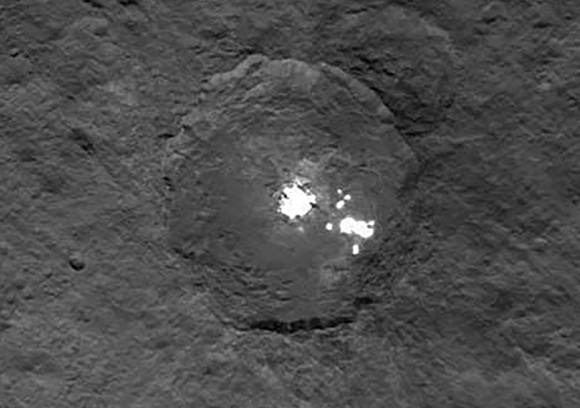
When photographing bright objects here on Earth, we expose “for the highlights” or the bright areas in photos to avoid overexposure and loss of detail.
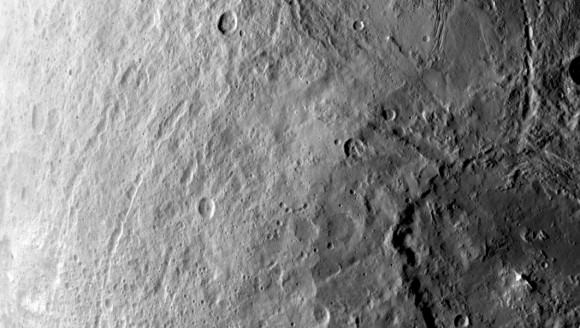
Naturally, when you try to capture details in something bright, your background will go dark. But that might be what’s needed here – a change in exposure to reveal more detail in the spots at the expense of the landscape. Doubtless NASA will release enlarged and detailed images of these enigmatic dots later this summer. Just call me impatient.
Scientists still don’t understand the nature of the spot cluster, but reflective ice or salt remain the strongest possibilities.
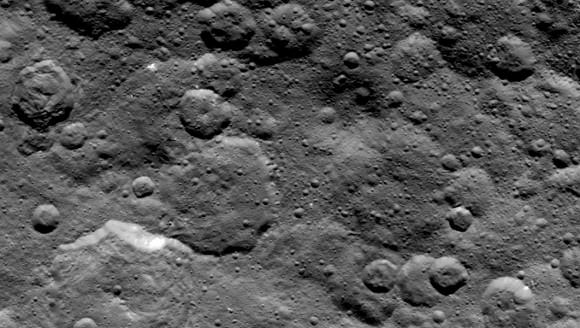
“The bright spots in this configuration make Ceres unique from anything we’ve seen before in the solar system,” said Chris Russell, principal investigator for the Dawn mission. “The science team is working to understand their source. Reflection from ice is the leading candidate in my mind, but the team continues to consider alternate possibilities, such as salt.”
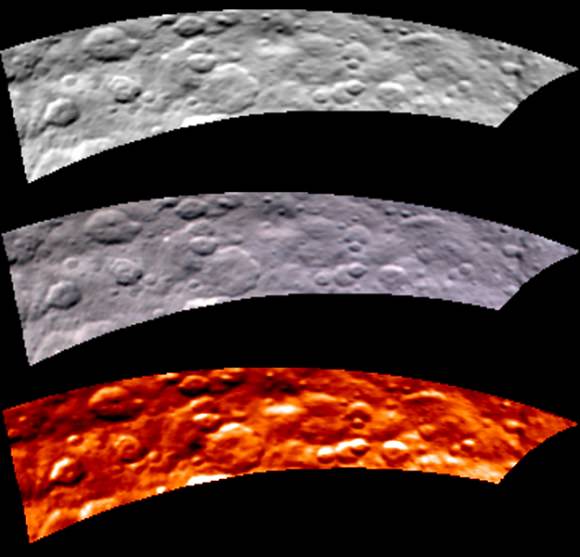
It’s interesting to compare and contrast Ceres with Dawn’s first target asteroid, Vesta. Craters of every size dominate both small worlds, but Ceres shows evidence of a more activity in the form of relaxed crater rims (possibly due to ice deformation), landslides and collapsed structures.
Dawn takes about three days to orbit at its current 2,700 mile altitude. It will continue to take photos and make science observations until dropping into a new lower altitude of 900 miles (1, 450 km) in early August.

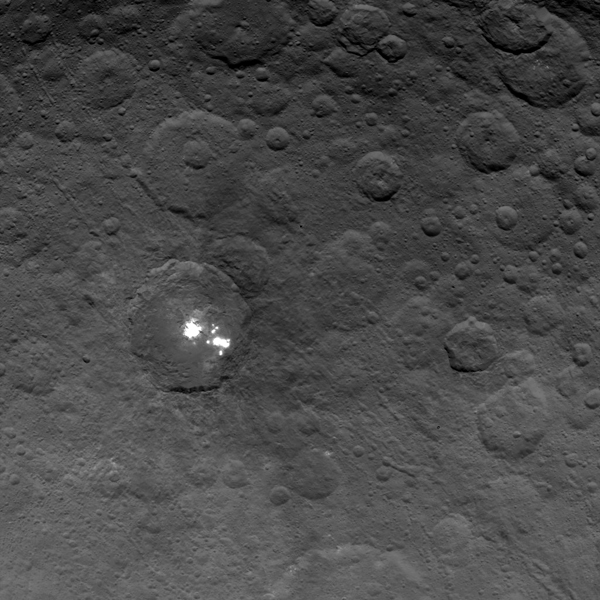
I copied that first image and took it into a photo editing program. I zoomed in as close as that res. would allow then raised the contrast level way up, Then I lowered the brightness and mid tones.. and the spots continued to be bright white. BUT, with those changes the two major spots looked more and more like ‘snow’ covered mountaintops. Try it and see what you think?
Then again, there’s a possible perspective shift going on when you do that.. such as when a crater looks like a mound.
Still quite the mystery…
Hi Aqua,
I tried working them in Photoshop a little (will work on them more when I have time) but I couldn’t really squeeze any more details. I’ll try your method, but I think I see how they might look that way because the main one has one or two dark “creases” slicing into pure white.
The analysis in that last paragraph of your article makes a whole lot of sense. I note that in some of the other images there are also lighter spots, though not nearly as white. Could those spots once have been MUCH brighter? Now darkened due to space weathering? GO DAWN!
Aqua,
Back at you again. I just did your procedure, and they look like artifacts from stretching the processing too far.
Be careful of that, soon you get Photoshop artifacts and people start to think that NASA is covering up cities on Mars, errrr I mean Ceres.
On the contrary, Olaf… Richard C. Hoagland, the undisputed master of planetary image clarification has used this and many, many, many, many, many other such techniques to show us (among many, many, many, many, many other such things) Glass Cities on the Moon, Panzer Tanks on Mars and spotted Unicorns on Uranus (pronounced wrong)…. LOL!
Am pretty certain the images show the white spots whiter than they actually are. I would be good to see if they throw any sort of shadow. I think I know what they are.
Roseland Observatory
I am assuming that Ceres is pretty dark, so the image is overexposed.
Either something crashed on it and exposes Ice.
Or something of ice crashed on it.
However, who knows, in the 70’s the Russians could have had a secret space mission, tried to land in that crater and crashed.
I really hope that it is an alien space craft that crashed. Or better a monolith.
Several aspects could be done to increase the features of the spots:
1) exposure, as noted above; 2) side view to see any vertical features;
3) Take angle if incidence of sunlight and see if reflectance of sunlight is viable, or falsified. 4) Devise what the structures must look like in order to reflect sunlight to cameras, and whether such structures would reflect at the required intensity.
That these simple tools were not employed says what about JPL?
See my post below to explain why 1) is being done already. 2) They have already released observations like this and will undoubtedly do more as the lower their orbits. 3) They have already announced that it is reflected sunlight. 4) I imagine they will do this work if it is scientifically warranted and after they have a clue as to what the bright material is.
That you apparently haven’t paid much attention to this, but chose to comment disparagingly anyway, says what about you?
ZING!!! Kudos on the correction!
Early infrared images indicated no or little difference in temperature of bright dots and its surrounding area. That seemed to rule out ice at the time. Other bright areas showed a difference in temperature compared to their surroundings. Since then I have read no further mention of infrared images of this area. What is the latest on that?
wsb,
I have seen no additional infrared images. Pity the one they supplied wasn’t of the crater and spots.
We need a Ceres Lander. That’s it.
Nice follow up Bob thank you, But I must have better eyesight than all of you because I clearly see at least 8 Vents (darker than the white frozen liquid) they seem to be venting liquid which is then freezing and falling into the white areas there are 4 vents around the central main peak and 1 vent on each of the lesser white areas now its either that or its a deserted clincoocoo mining camp clincoocoos are renowned hit and run miners who always leave their sites in a mess….. 🙂
Any chance we are looking at a dense form of water ice? Perhaps from the impact?
BlackWolf,
That I don’t know, but ice at an atmosphere-less Ceres would be very cold since its average distance from the Sun is 257 million miles, more than 100 million miles farther than Mars. Assuming it is ice, it could be water or the CO2 variety or maybe both.
Methane clathrate/hydrate ice?
Thank You.
I was wondering because Ceres has been around since near the beginning of our solar system. Which means it could have been made up of a lot of water ice that was floating around at the time. Or a lot of CO2 as you stated.
I do think Ceres is pretty much dead geology speaking. If it was active, the face of Ceres would show signs of covering where something melted and covered the surface either through some form of volcanism or geysers. And we just don’t see any long term spraying effects of geysers.
As it is in the middle of a crater it`s obvious that it`s the remain of a melted substance (water or CO2) at the impact. After that it froze back into those small lakes. If it`s CO2 than it means that this celestial body has the same dust tornadoes like Mars does, that`s why the image changes every time, according to what parts of the frozen lakes the dark dust covers.
Ceres hasn’t got an atmosphere, so there is no way it can have dust tornadoes.
how do you know that? a very faint CO2 atmosphere is very possible there , as on mars.
How do you know how obvious all you claim is? I love it when people say things about how obvious something is when NASA and others don’t even know yet. Right there one should automatically tune out the rest of the comment and move on. BTW, if it does have one, as the Wiki article you linked even states, the atmosphere is tenuous, meaning it’s very, very thin (MUCH more so than Mars’) and thus likely incapable of hosting wind related events.
http://en.wikipedia.org/wiki/Ceres_%28dwarf_planet%29#Atmosphere
I still go with an ex-craterlake with saltwater vents (not geysers, just fumes) … where the salts got deposited.
The more so, now I noticed features of the crater itself, including the total lack of secondary cratering and the calving of the craterwalls show age, probably due to impact quakes.
Ice would have sublimated in near vacuum, especially with an Obvious abundance of sunlight.
Does the separation of the spots suggest that they were created by some discrete event(s) rather than a continuous outflow?
I feel like I’m always waiting for raw, lossless images lately. I never know if these have been processed by someone who clipped the histogram and destroyed any details or if it’s just the exposure. If the raw data is a 16-bit or 32-bit image, it could contain details in the extreme bright parts even in longer exposures.
the problem is that we might never get better images, i don`t know if it will ever be closer to this celestial body. And the real question is the changing nature of the white spots shape.
“i don`t know if it will ever be closer to this celestial body”…
REALLY!? Perhaps you should have finished reading the very article on which you’re commenting. The last paragraph states that, “It will continue to take photos and make science observations until dropping into a new lower altitude of 900 miles (1, 450 km) in early August.”
Good Job!
Try to zoom in on this GIF:
http://i.imgur.com/92iruXN.gif
I am hoping the autor could make a new one with the new orbit data.
For me it looks like material ending in a crater sorunded by hills.
What the material is and why it is only here? Thats a very good question =)
Her’s a guess. Since Ceres’s proposed structure has a dusty crust covering a layer of ice, perhaps, when there is a meteor impact the ice is sucked up into the central peak sometimes. Thus when the regolith slides off the peak it exposes the ice. Considering the depth of the crust is not uniform across the (dwarf) planet sometimes it comes up and sometimes it doesn’t. Maybe…
Regard,
/hydrazine
What are peoples’ views on similarities too the bright feature(s) within Umbriel’s crater Wunda?
For Bob, and all you commenters critical of the exposures of the bright spots, there is a good reason for they do this. Ceres has not been visited before. Therefore, its gravitational field is not known. In that case, a spacecraft has to settle into an orbit and it just takes a while to collect the radiometric data before the effects on the motion of the spacecraft can be predicted. Dawn’s commands are built weeks in advance and they cannot know where in the orbit the spacecraft will be at any given moment. Therefore, they don’t know when the spacecraft will be over the bright spots. So they take pictures of the entire surface with the exposure first chosen to suit the majority of the surface. Then they will re-image the whole surface with exposures changed to better accommodate specific targets (the bright spots).
So everybody quite whining and making insults and just wait.
“Dawn’s commands are built weeks in advance and they cannot know where in the orbit the spacecraft will be at any given moment. “… Erm… NO! Of course they know exactly where it is in it’s orbit. Even with pre-administered commands, all they need to do is Math.
Unfortunately, doing the math is the problem. They can target a given altitude, a given orbit. But until the mass of Ceres is precisely known, they don’t know how fast the spacecraft will go around it, therefore they can’t predict when it will be over a given longitude. They have to keep the spacecraft in an orbit for a while and see how the spacecraft moves, and back out the mass of Ceres from that. There are also secondary effects of oblateness and other distortions of the body that add to the uncertainty. Apparently it is all uncertain enough that, over days and weeks, they can’t really target a specific place like the bright spots, at least when they first arrive in an orbit.
It seems to me, like liquid covering surfaces holes. The brightness only occurs when that crater is hit by sunlight, so, I’d guess it’s malleable material metal like (so, reflective), whose shape would be influenced by Ceres internal activities. In other words, some wounds on Ceres surface?